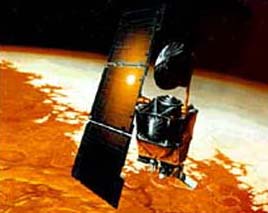Click on image for full size
Courtesy of NASA
Related links:
NASA Loses Climate Orbiter
News story originally written on September 27, 1999
Last Thursday was supposed to be a triumphant one for NASA, but turned out to be a disaster. The Mars Climate Orbiter was scheduled to begin its orbit around the Red Planet early that morning. However, during an engine firing that would have sent the craft into orbit, the probe travelled too close to the planet. Scientists are assuming that the spacecraft burned up during its descent.
"We believe the spacecraft came in at a lower altitude than we predicted," operations project manager Richard Cook said. "Depending on how low that was, it could be the total loss of the mission."
NASA did not have contact with the satellite during the firing, but was supposed to regain contact shortly thereafter. Unfortunately, the $125 million project appears to be lost. The probe was expected to study Mars' climate for one Mars year, or 687 days. Along with The Mars Polar Lander, the orbiter may have proven that water exists on the neighboring planet. Now, even the Polar Lander mission is in jeopardy.
This is just the latest setback in a series of errors and malfunctions that has plagued NASA's exploration of our fellow planet. In 1993, the Mars Observer was lost shortly before reaching Mars. A similar mission in the Soviet Union was also lost during a launch failure.
The failure comes during a critical time for NASA. Congress is currently battling over how much money the agency should receive next year. This latest disaster may hinder any chance of retrieving the $1 billion cut from the budget by the House of Representatives.














